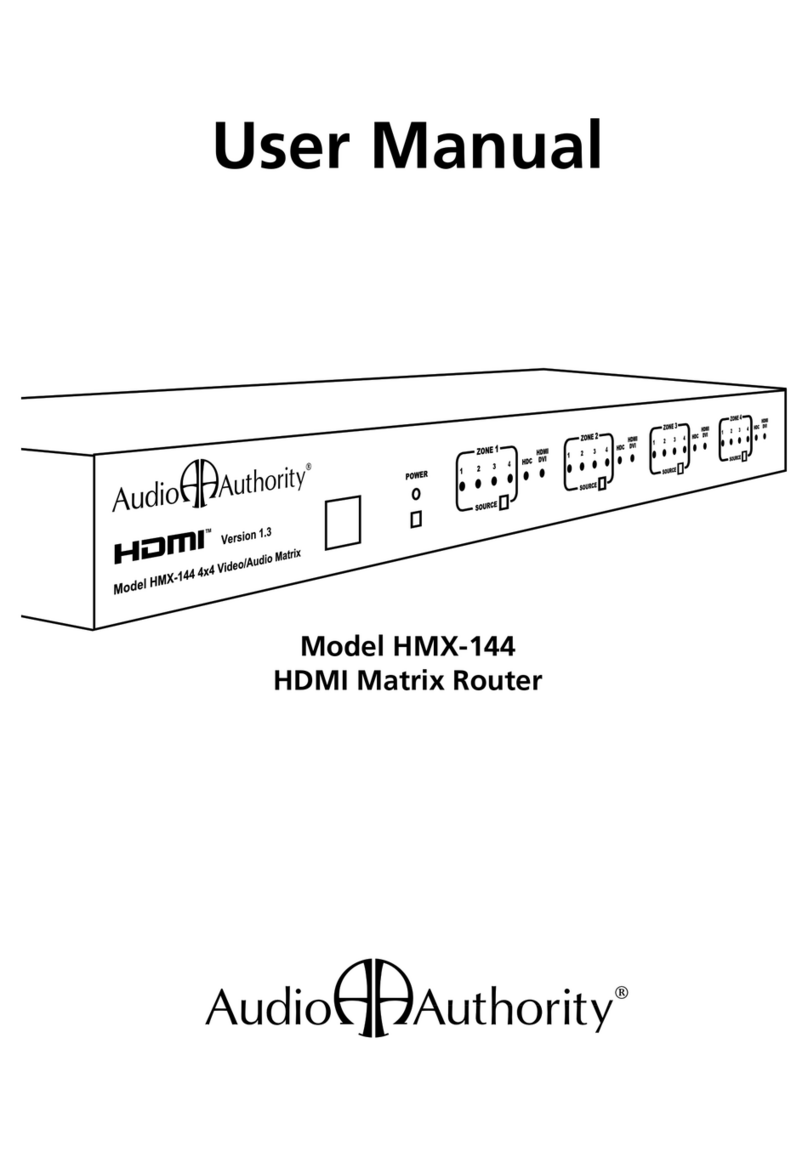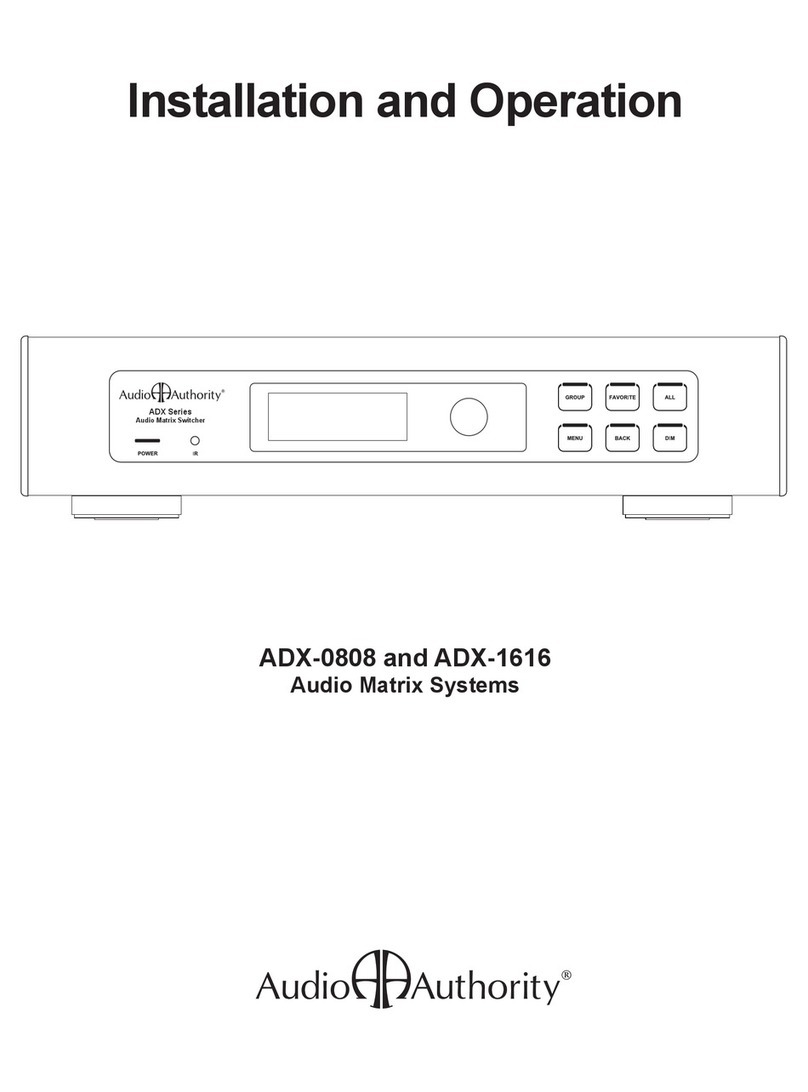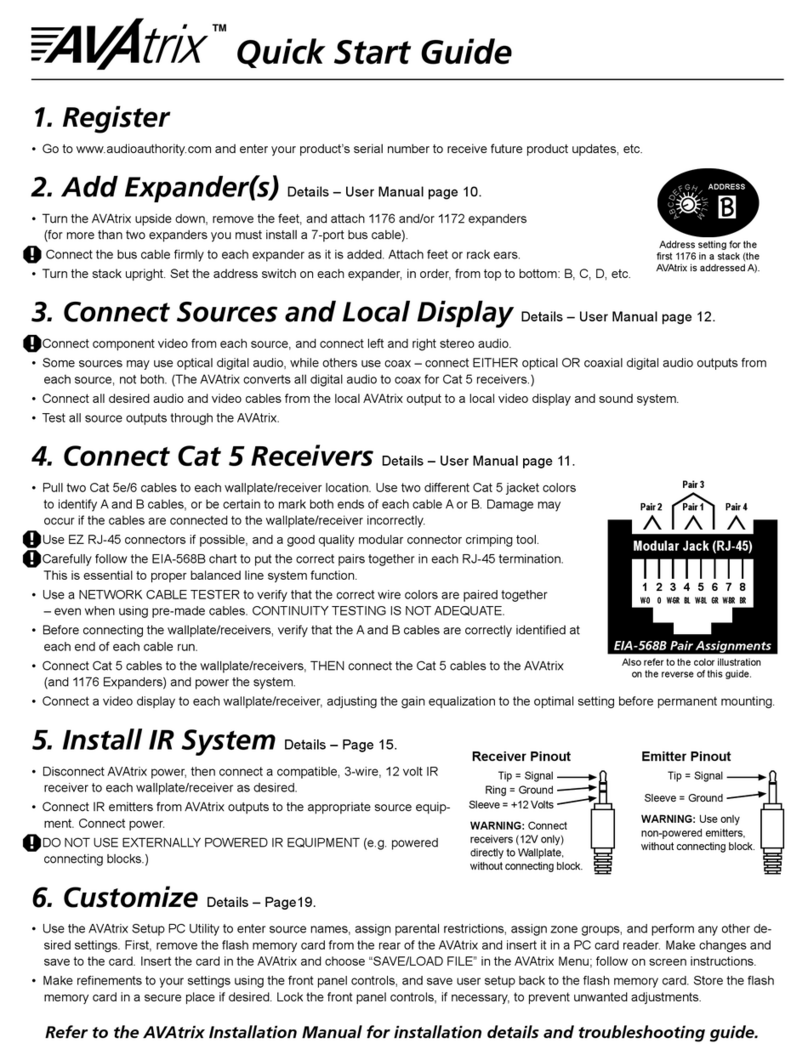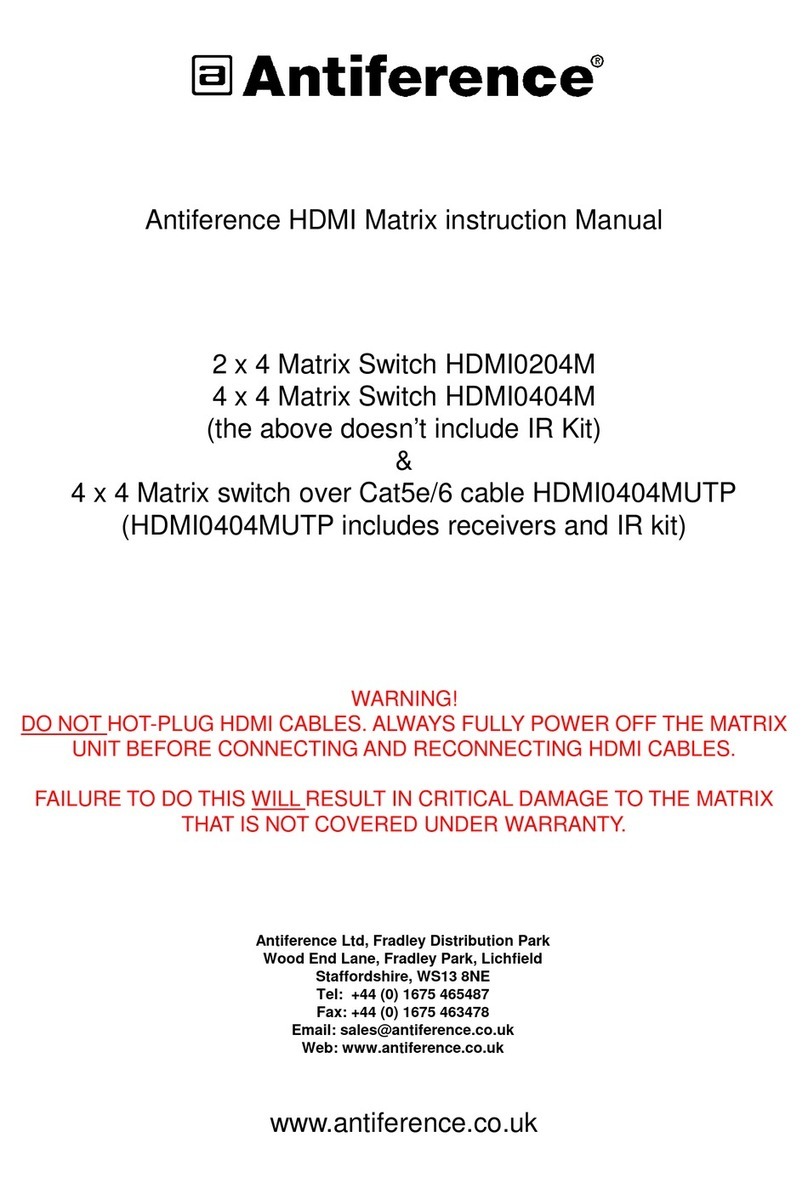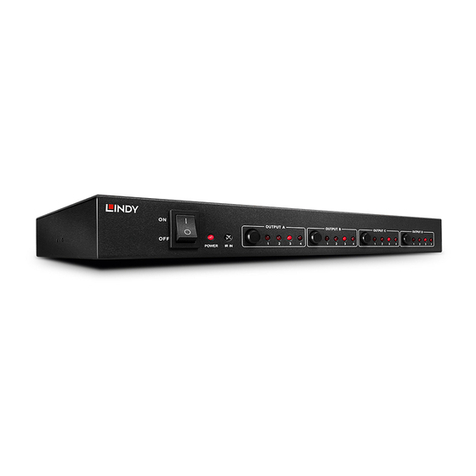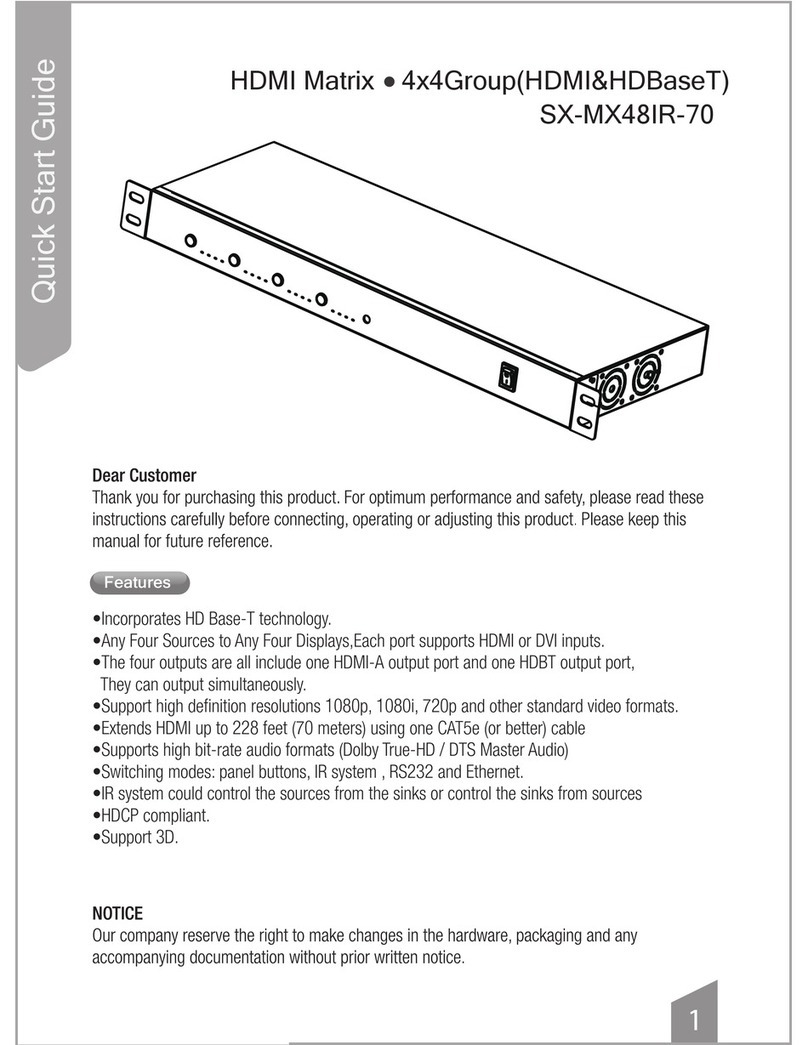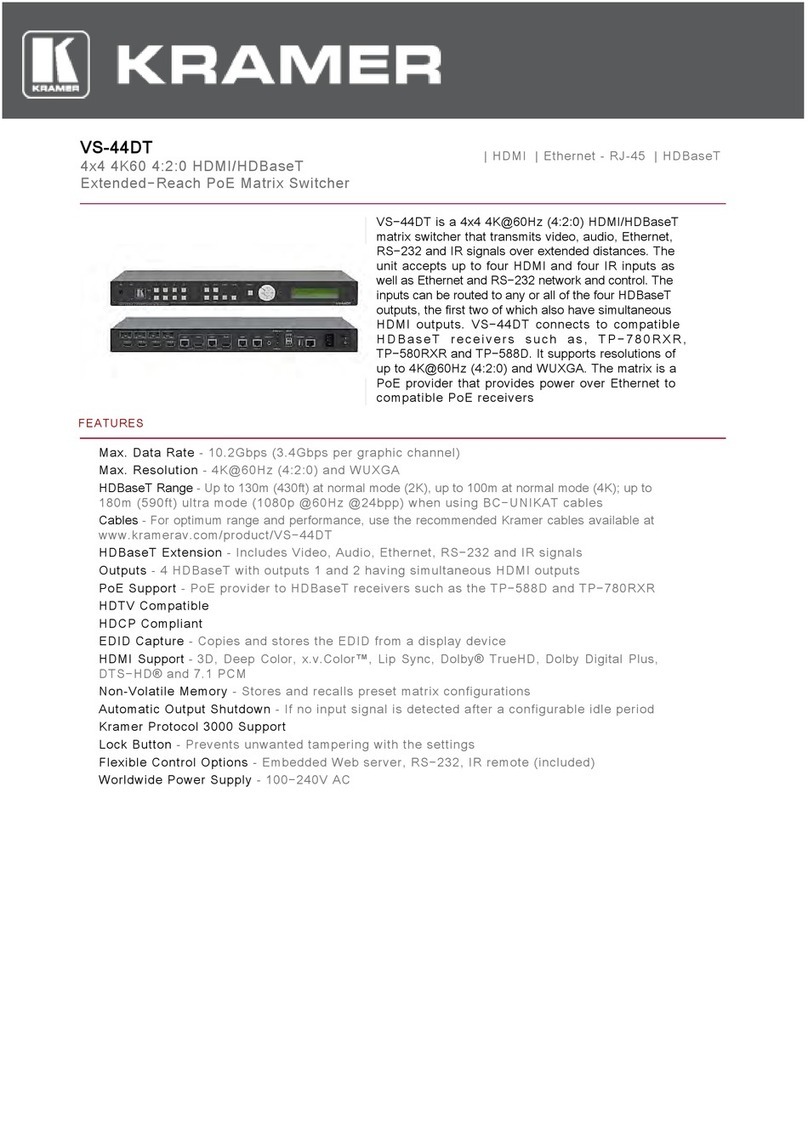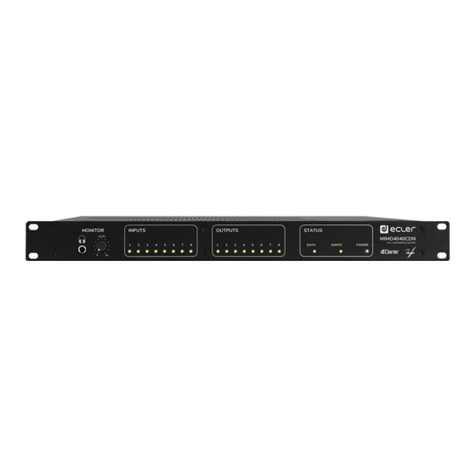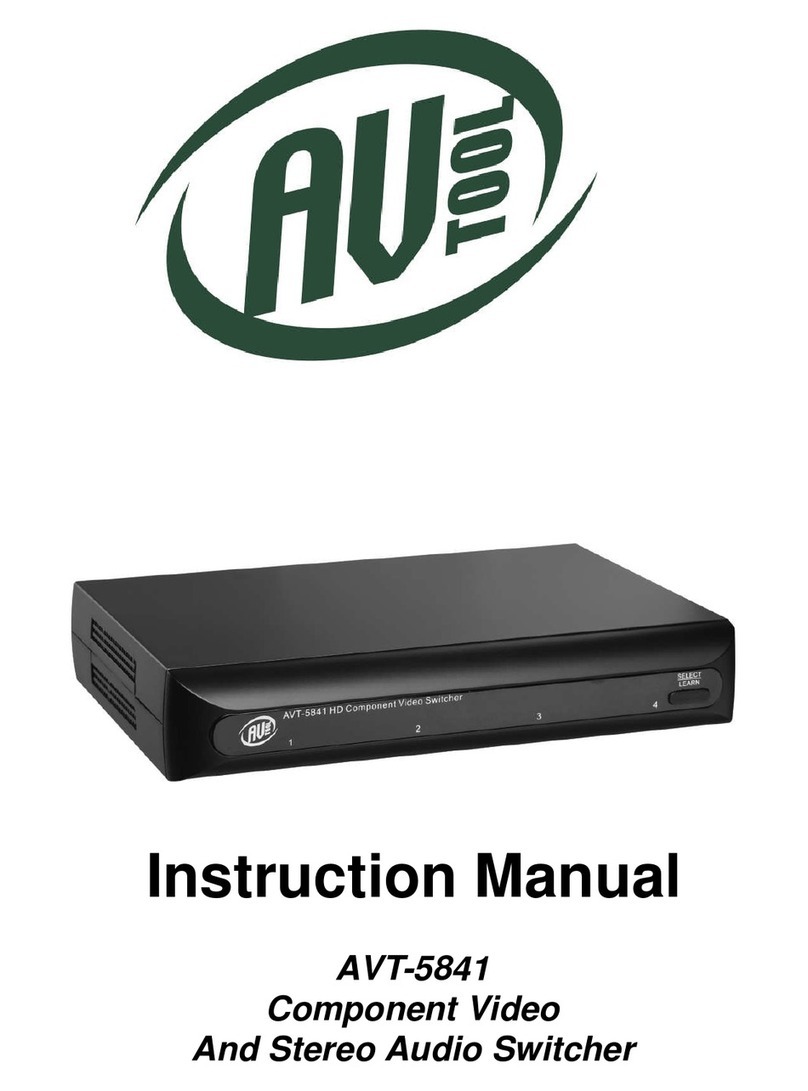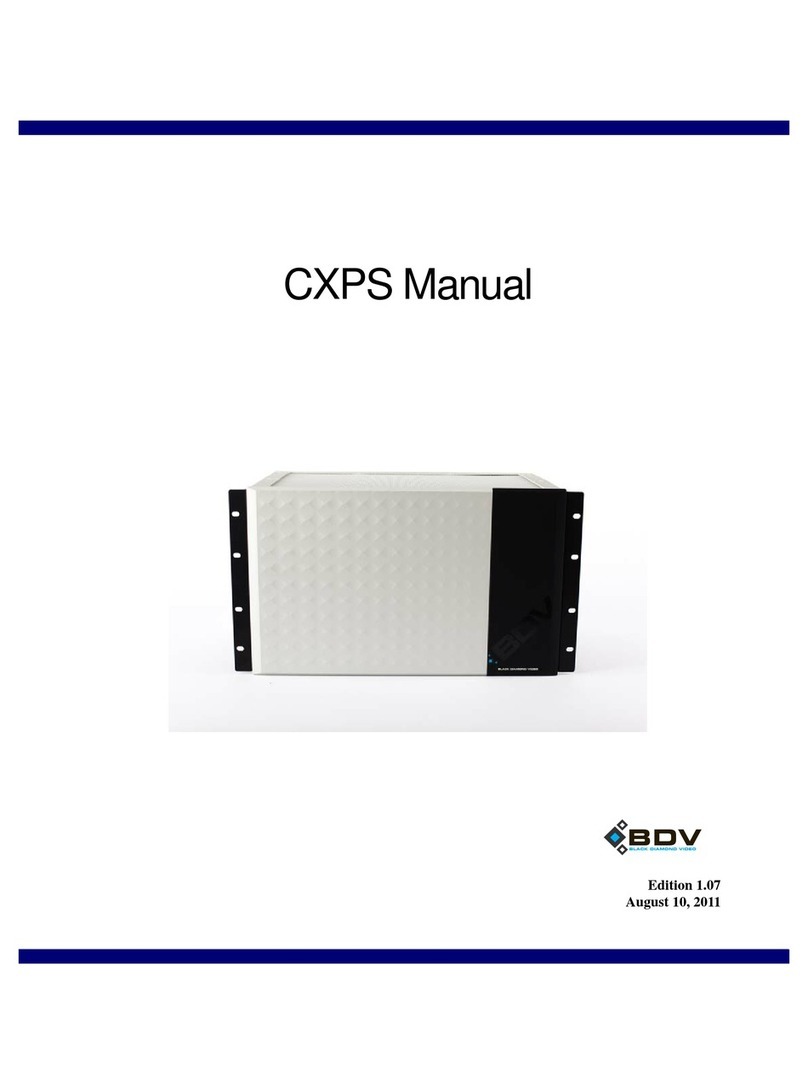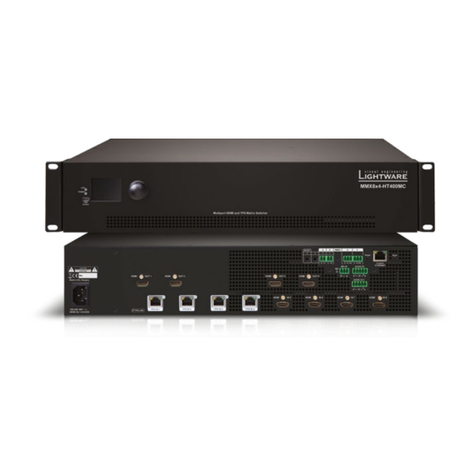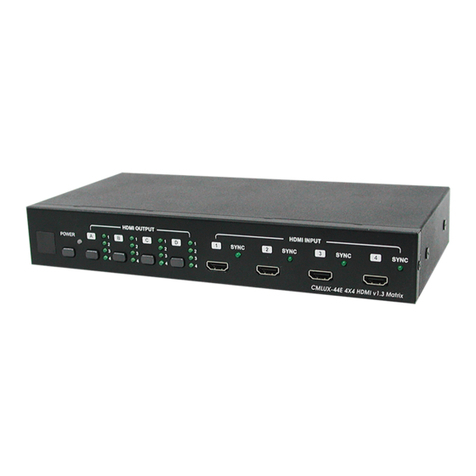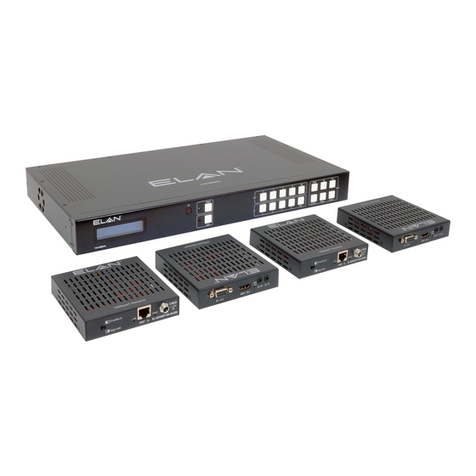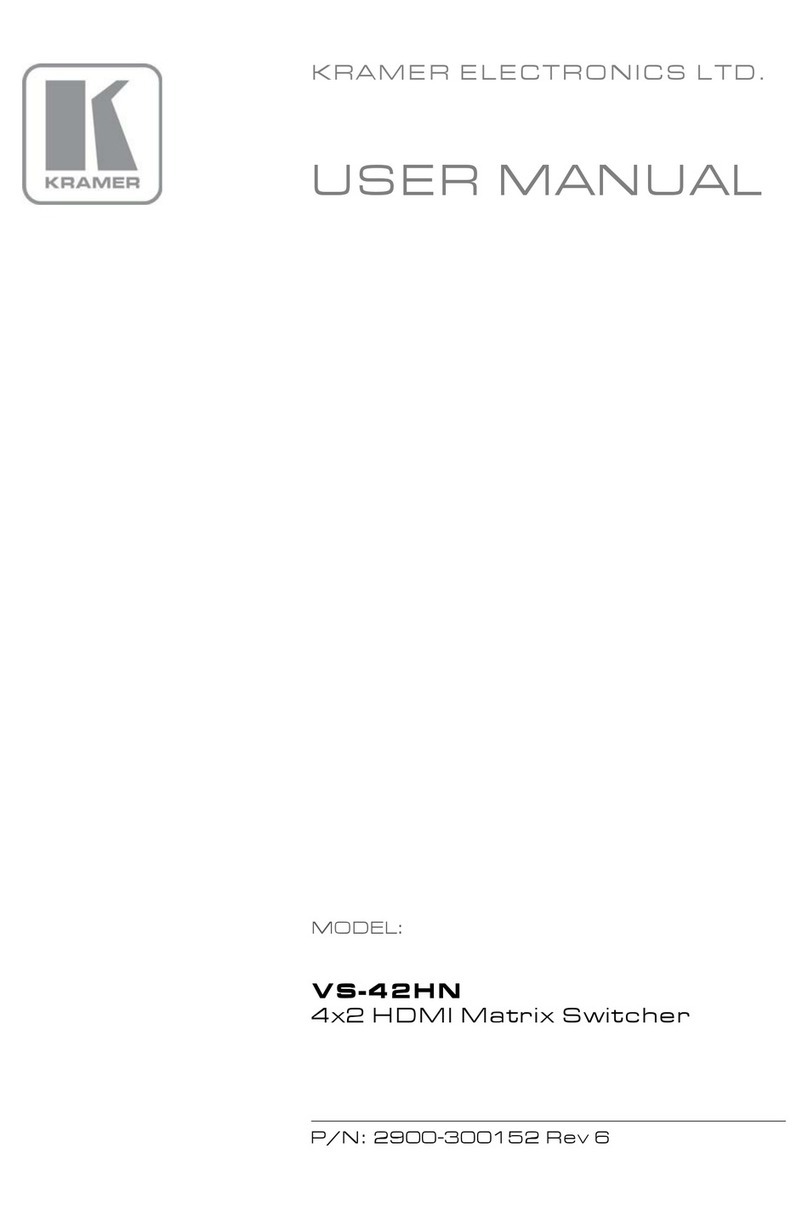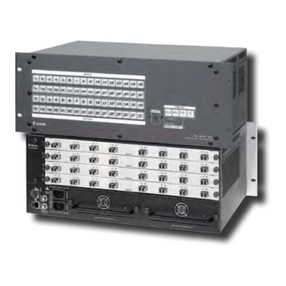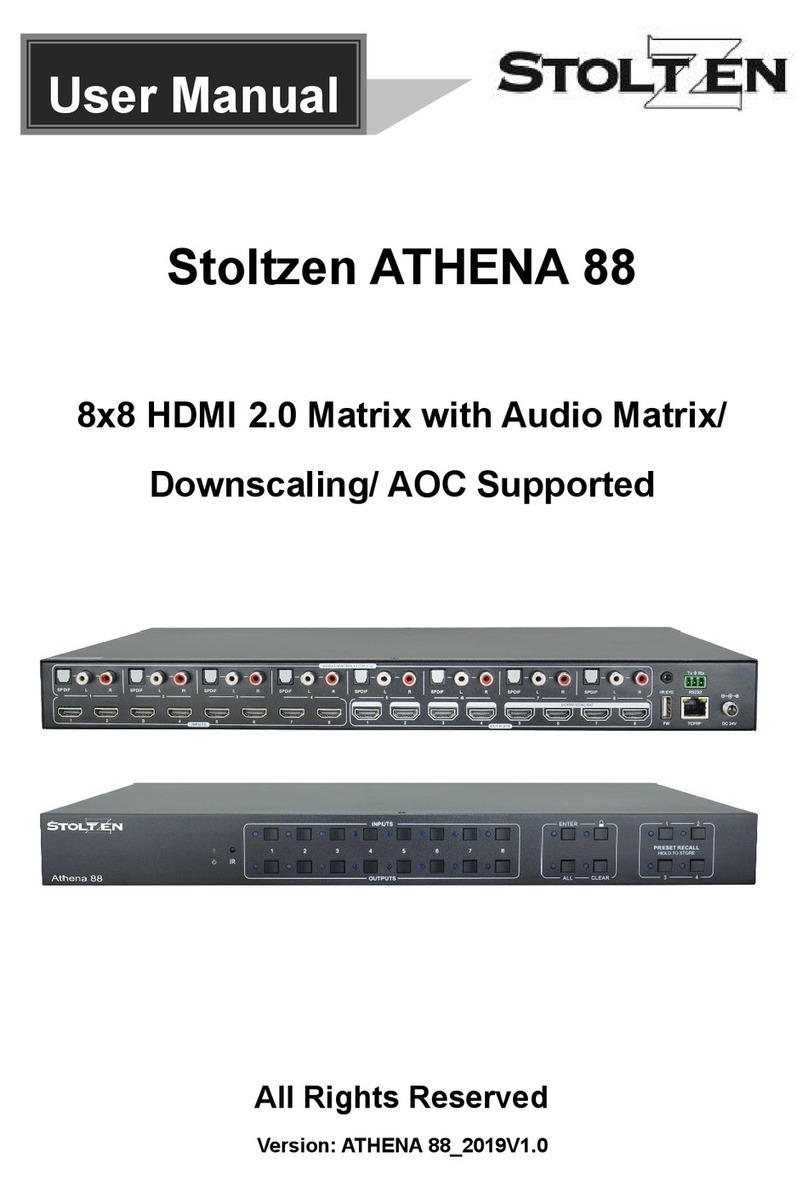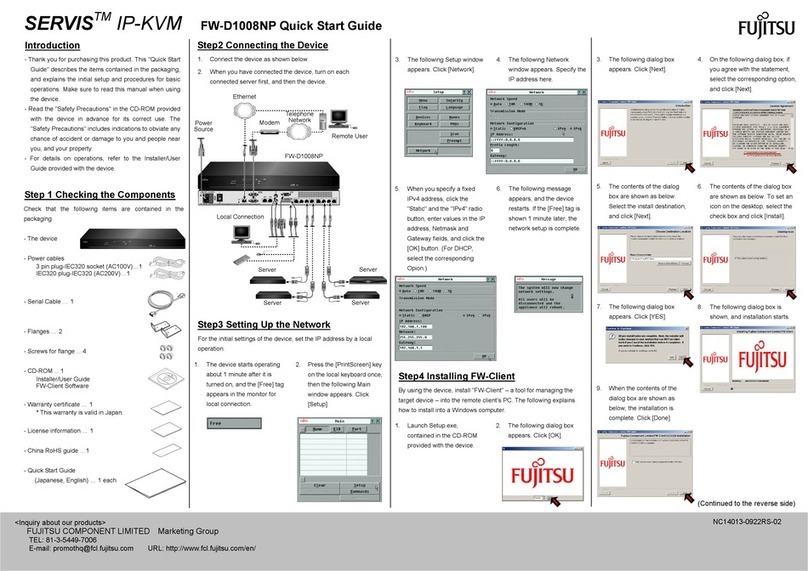Audio Authority ADX-0808 Operating instructions

Installation and Operation
Model ADX-0808
Model ADX-1616
Audio Matrix Systems
L
R
L
R
OUT TO AMPLIFIER
ZONES 1 - 8
OUT TO AMPLIFIER
ZONES 9 - 16
USB
ETHERNET
RS-232 SERIAL
1 2 3 4 5 6 7 8
9 10 11 12 13 14 15 16
L
R
L
R
1 2 3 4 5 6 7 8
9 10 11 12 13 14 15 16INPUT
INPUT
OUTPUT
OUTPUT
1- SLEEVE = +12V
2- RING = GROUND
3- TIP = SIGNAL
800-322-8346 • 859-233-4599
www.audioauthority.com
LINK
SPEED
18V DC
POWER
IR
INPUT
3.5MM
IR
Model ADX-1616 Audio Matrix
ADX Series
Audio Matrix Switcher

2
ADX Serial Number
Custom Installer
Telephone Number

3
Model ADX-0808
Model ADX-1616
Audio Matrix Systems
Installation and Operation Manual
Audio Authority and the Double-A Symbol are registered trademarks of Audio Authority Corp.
Copyright June, 2009, all rights reserved.
Audio Authority®Corporation Lexington, Kentucky
www.audioauthority.com • 800-322-8346
Table of Contents
Introduction . . . . . . . . . . . . . . . . . . . . . . . . . . . . . . . . . . . . . .4
Warnings . . . . . . . . . . . . . . . . . . . . . . . . . . . . . . . . . . . . . . . . 4
Panel Descriptions . . . . . . . . . . . . . . . . . . . . . . . . . . . . . . . . . . . 5
Getting Started. . . . . . . . . . . . . . . . . . . . . . . . . . . . . . . . . . . . . 6
Installation . . . . . . . . . . . . . . . . . . . . . . . . . . . . . . . . . . . . . . . 7
Advanced Setup and Remote Control Options . . . . . . . . . . . . . . . . . . . .8
Using Ethernet, RS-232, and IR . . . . . . . . . . . . . . . . . . . . . . . . . . . . 8
Operation . . . . . . . . . . . . . . . . . . . . . . . . . . . . . . . . . . . . . . 10
Appendix A: Serial Commands . . . . . . . . . . . . . . . . . . . . . . . . . . . 13
Appendix B: Upgrading ADX Firmware . . . . . . . . . . . . . . . . . . . . . . . 16
Appendix C: Troubleshooting . . . . . . . . . . . . . . . . . . . . . . . . . . . . 16
Specications . . . . . . . . . . . . . . . . . . . . . . . . . . . . . . . . . . . . 17
Limited Warranty . . . . . . . . . . . . . . . . . . . . . . . . . . . . . . . . . . . 17

4
Introduction
The ADX is the industry’s most controllable analog audio matrix, featuring multiple control interfaces and an attractive design
that is sure to compliment any equipment rack or shelf. Capable of distributing sixteen analog audio channels to sixteen
destinations, it is the perfect solution for analog audio distribution in both small and medium size installations.
Features
• Sixteen source input, sixteen zone output matrix switcher (ADX-1616) or eight source input, eight zone output matrix
switcher (ADX-0808)
• Rack mountable with included 2U rack mount ears
• Control via Ethernet, RS-232 Serial, front panel IR, rear panel IR, and front panel controls
• Capacitive touch front panel – easy to clean and no physical buttons to wear out
• IR codes available for use with third party control systems
• USB 1.1 and 2.0 compliant for the convenient Import and Export of system congurations as well as future Firmware
updates
• Manufactured in Lexington, Kentucky USA
Carton Contents
• Model ADX-1616 or ADX-0808 Analog Audio Matrix
• 18-volt power supply
• Rack ears
• User manual
Other Materials You May Need
• Patch cables (Ethernet, RCA)
• Infrared receiver
• Third party programmable remote
• USB 1.1 or USB 2.0 compliant drive
To reduce the risk of re or electric shock, do not expose this unit to rain or moisture.
The exclamation point symbol alerts users to important operating and
maintenance instructions in this booklet.
• Read this manual before installing or using this product.
• This product must be installed by qualied personnel.
• Do not open the cover—there are no user-serviceable parts inside.
• Do not expose this unit to excessive heat.
• Install only in dry, indoor locations.
• Do not obstruct the ventilation slots.
• Clean the unit only with a dry or slightly dampened soft cloth.
!
Warnings

5
L
R
L
R
OUT TO AMPLIFIER
ZONES 1 - 8
OUT TO AMPLIFIER
ZONES 9 - 16
USB
ETHERNET
RS-232 SERIAL
1 2 3 4 5 6 7 8
9 10 11 12 13 14 15 16
L
R
L
R
1 2 3 4 5 6 7 8
9 10 11 12 13 14 15 16INPUT
INPUT
OUTPUT
OUTPUT
1- SLEEVE = +12V
2- RING = GROUND
3- TIP = SIGNAL
800-322-8346 • 859-233-4599
www.audioauthority.com
LINK
SPEED
18V DC
POWER
IR
INPUT
3.5MM
IR
Model ADX-1616 Audio Matrix
ADX Series
Audio Matrix Switcher
A B C D
E
H
GF
I J
L
R
L
R
OUT TO AMPLIFIER
ZONES 1 - 8
OUT TO AMPLIFIER
ZONES 9 - 16
USB
ETHERNET
RS-232 SERIAL
1 2 3 4 5 6 7 8
9 10 11 12 13 14 15 16
L
R
L
R
1 2 3 4 5 6 7 8
9 10 11 12 13 14 15 16INPUT
INPUT
OUTPUT
OUTPUT
1- SLEEVE = +12V
2- RING = GROUND
3- TIP = SIGNAL
800-322-8346 • 859-233-4599
www.audioauthority.com
LINK
SPEED
18V DC
POWER
IR
INPUT
3.5MM
IR
Model ADX-1616 Audio Matrix
ADX Series
Audio Matrix Switcher
O
N
PQR
L
K M
S
Getting to Know the ADX
*ADX-1616 shown
APower Indication LED DMulti Function Knob GAll Selection Button JDim Button
BFront Panel IR Receiver EGroup Selection Button HMenu Selection Button
CVacuum Fluorescent Display (VFD) FFavorite Selection Button IBack Button
KAnalog Audio Input Jacks 1-16 for ADX-1616 or 1-8 for ADX-0808 NEthernet Connector with Link and Speed Indicators Q3.5MM IR Input Jack
LDB25 Connector(s) for future use OUSB Connection Port R3-Wire IR Input Terminal Block
MAnalog Audio Output Jacks 1-16 for ADX-1616 or 1-8 for ADX-0808 PRS-232 DB9 Connector S5.5MM 18V Center Positive Power Connection

6
Getting Started
• Conrm that nothing is missing from your shipping carton. Refer to Carton Contents on page 4.
• Record the serial number (found on the product rear panel) in the space provided on the inside of the front cover of this
manual for easy reference.
• Activate your warranty and receive future upgrade notications by registering your purchase on our website,
www.audioauthority.com/register.
• Read the entire instruction manual to become familiar with the various terms and operations of this product.
Although it is highly recommended that you follow the more detailed installation instructions provided in this manual, a very
basic installation may be accomplished by performing the following steps:
1. Connect your source equipment to the input jacks 1-16.
(You can nd detailed instructions in the Installation Section)
2. Connect your audio receiver equipment to the zone output jacks 1-16.
(You can nd detailed instructions in the Installation Section)
3. Connect the product to a suitable power outlet using only the power supply furnished. Once power has been
connected, the ADX will power on, there is no power button or switch. After a moment for the system to boot, the
ADX is ready to control your new audio system matrix. Use the front panel controls to select the input port number of
your preferred source and the output port number(s) of your preferred listening zones.
Now relax and enjoy your audio.
Choosing a Control Interface
For more detailed instructions on the various control methods available to you, please refer to the following sections:
• If you prefer to control the ADX through RS-232, see page 8
• If you prefer to control the ADX through Ethernet, see page 8
• If you prefer to control the ADX through IR, see page 9
• If you prefer to control the ADX with the Front Panel, see page 10
Control Interface
Capabilities
All commands are
available on Ethernet and
RS-232, but other control
methods are limited as
shown.
RS-232 Ethernet Infrared Front Panel
Audio signal switching X X X X
Dimming X X X
Lock IR X X
Lock front panel interface X X
Change Ethernet settings X X
Upgrade rmware X
Group and Favorite creation X X
Group and Favorite switching X X X X

7
Installation
The ADX is easy to set up for both simple and advanced installations. Perform the following steps.
Installing the ADX
The ADX is conveniently designed so that it may be installed either on a shelf or in
a standard 19-inch equipment rack. If rack mounting, remove the feet and the cover
screws adjacent to the front panel of the unit. Reuse the cover screws to mount the
Model 1192A rack adapters supplied with the ADX. Be sure to place a spacer under
the adapters at every screw location. Secure the ADX to the rails of the equipment
rack with the screws supplied with the rack adapter kit.
Initial Audio Setup
Independently test each component to be connected to the ADX prior to system assembly. This will greatly reduce
time-consuming troubleshooting measures later. Verify basic ADX functionality by performing the
following steps:
1. Connect one source unit to a pair of input jacks numbered 1-8.
2. Connect one audio receiver to a pair of zone output jacks numbered 1-8.
3. Use high quality cable and keep the lengths as short as possible.
4. Turn on the source, receiver and the ADX for an initial test. Verify the audio pathway is performing acceptably by selecting
the appropriate source input and zone output from the front panel (detailed instructions for Front Panel operation can be
found on page 10). You should now hear the source material being played. If you do not, please refer to the
Troubleshooting section found on page 16. If you are still experiencing difculty, please contact Technical Support by
phone at 859-233-4599 or toll free in the US at 1-800-322-8346.
5. Repeat steps 1-4 with jacks numbered 9-16.
6. If no problems have been noted, remove power and continue installation.
I/O Connections and Testing
• Determine the correct wiring conguration for your setup. It is a good idea to label the RCA cables as to the actual location
they either come from or go to (e.g. Input 1 - Cable Box, Input 2 - Music Server, Zone 1 - Kitchen, Zone - 2 Living Room etc.)
Be sure to use good quality RCA cables for optimal results.
• Connect the ADX power supply; the unit will immediately power on.
• Apply power to all sources and associated equipment. Use the front panel controls to verify audio signal integrity of sources
at each zone location.

8
Advanced Setup and Remote Control Options
Using the RS-232 Port.
System controllers and PCs can send all setup and control commands as well as receive feedback via the RS-232 serial port.
• Important: If a PC is connected directly to the ADX RS-232 port, use a standard serial cable.
• The baud rate is set to 9600 by default, but this may be changed using the Front Panel Menu screen “Serial”. The other
connectivity parameters are xed to 8 data bits, no parity, 1 stop bit, and no ow control.
• See the table and diagram below for the ADX serial port pinout.
This control method is capable of performing all commands (See Appendix A).
Ethernet
Serial commands can be issued using an Ethernet connection and a telnet program.
There are two LED indicators located next to the Ethernet port on the rear panel that will help in identifying connection
issues:
• Link - The Link LED is steadily lit if a connection is detected and ashes when activity is present.
• Speed - The Speed LED is off for 10 base T, and on for 100 base T.
Using the Ethernet Port
Use of a telnet client or terminal program on a Mac or PC allows commands to be sent through the Ethernet port on
the ADX. Connect a PC directly to the Ethernet port using a crossover cable, or alternatively use a standard Ethernet hub
or switch and a standard patch cable. Once connected to a PC or network, the ADX by default will attempt to obtain an IP
address automatically using DHCP. To use Static settings, see the detailed instructions on page 9.
5 4 3 2 1
9 8 7 6
GND RX TX
N
Transfer Rate 9600 bps Default (may be changed, see Appendix A)
Data Bits 8
Parity None
Stop Bits 1
Flow Control None or Off
Character type ASCII
Connector DB-9
Electrical Rat-
ing
Pins 2 and 3, ±15 VDC
Pin out Pin 2, Tx
Pin 3, Rx
Pin 5, Ground
Shell, Ground
Actual screen from ADX showing Serial Settings
DB-9 connector on rear panel of ADX
P
L
R
L
R
OUT TO AMPLIFIER
ZONES 1 - 8
OUT TO AMPLIFIER
ZONES 9 - 16
USB
ETHERNET
RS-232 SERIAL
1 2 3 4 5 6 7 8
9 10 11 12 13 14 15 16
L
R
L
R
1 2 3 4 5 6 7 8
9 10 11 12 13 14 15 16INPUT
INPUT
OUTPUT
OUTPUT
1- SLEEVE = +12V
2- RING = GROUND
3- TIP = SIGNAL
800-322-8346 • 859-233-4599
www.audioauthority.com
LINK
SPEED
18V DC
POWER
IR
INPUT
3.5MM
IR
Model ADX-1616 Audio Matrix
ADX Series
Audio Matrix Switcher

9
DHCP
If DHCP is enabled on your network, simply connecting the ADX to the network with an existing DHCP server will enable it to
obtain all necessary information. DHCP is enabled on the ADX by default.
Static addressing connected directly to a PC
The ADX must be given an IP address which will not conict with the PC. Go to the network settings (which are found in
control panel -> network -> local connection properties of a PC running Windows XP).
Change the TCP/IP protocol properties, and set the IP address, gateway, and subnet mask, if they are not already set.
This can be arbitrarily done on a direct connection, but a good choice for the settings would be IP address of 192.168.0.1,
subnet mask of 255.255.255.0, and an empty default gateway. Once these values have been set, use serial commands to
set the network settings of the ADX-1616 in a similar manner, but use a different IP address than that of the computer (for
example, 192.168.0.2).
Static addressing on a network
The ADX must be set to the same settings as the PC except for the IP address, which must be one available on the network.
To determine this in Windows, use the DOS prompt (Start->Run->cmd) commands ipcong and ping. Ipcong will list the PC’s
settings, and ping will allow you to test addresses to make sure that nothing else on the network has that address. Enlist the
help of a network administrator if you are unfamiliar with setting up a network connection.
Once connectivity is established, a telnet program such as Hyper Terminal, Teraterm, PuTTY etc, must be used to connect
to the device. Enter the IP address of the ADX and leave the default port (23) to connect. Once connected, standard serial
commands (listed in Appendix A) can be issued in an identical manner to serial control.
Using a Comprehensive IR Control System
The ADX uses a three wire IR circuit. It is imperative that the correct polarity be maintained when connecting third party IR
equipment. The 3.5MM pinout is shown in the illustration below and the connecting block pinout is screen printed on the back
panel of the ADX. Patch the IR signal from your IR receiver directly to the IR input port on the rear panel using the connec-
tion method of your choice. Alternatively, you may place a stick-on emitter from your infrared system on the ADX front panel
receiver.
If the ADX IR codes are available from your remote control company, download and/or activate those les.
A CCF le containing ADX codes can be downloaded from the Audio Authority
website,
www.audioauthority.com/page/software.
Tips for Using Infrared Control
• If you are using standard hand-held IR remote controls, ensure correct operation
by avoiding sources of light pollution such as Plasma and LCD TVs, direct
sunlight, uorescent light, etc. Experiment with the physical placement of the IR
receiver to avoid interference.
• If a source of interference cannot be eliminated or avoided, use IR receivers that
block that type of interference, such as Plasma-proof or LCD-proof receivers.
Tip = Signal
Ring = Ground
Sleeve = +12 Volts
Actual screen from ADX showing Network
Settings with DHCP set to ON

10
Operation
Front Panel
The front panel is operated by touching the sensitive key areas: Group , Favorite , All , Menu , Back , and Dim
to select the respective sub-menu. Once the desired screen has been selected, rotate the Multi Function Knob to navigate
to the item you want to change and press the knob to select that item. The previous selection is marked with a solid arrow “”,
and any others marked with an open arrow “.”
Zone/Source Selection Screen
This default screen performs zone/source switching. Rotating the knob while selecting the zone line selects a different zone.
Once the zone to be switched is selected, push the knob to move to the source selection line. Rotating the knob here allows a
new source to be selected for that zone. Press the knob to activate your selection.
Group Button > Group Selection Screen
This screen allows switching multiple output zones to a single input source through ten predened groups. Rotate the knob
while on the group selection line to choose the group. Push the knob to move the cursor to the source selection line. Rotate
the knob on the source selection line to select the source. Finally, push the knob to save the group of zones to the selected
source.
Group Switching
The ADX is capable of storing up to 10 Groups of Zones. Each Group may be assigned a unique name up to 16 characters in
length. Groups can only be congured and named using Serial commands. See Appendix A for the appropriate Group com-
mands.
Press the Group button, select the previously assigned Group number by rotating the knob until the desired Group is shown
and press the knob. Rotate the knob to select the desired Source.
Favorite Button > Favorite Selection Screen
This screen allows switching multiple output zones to multiple sources through ten predened favorites. Rotate the knob to
select a favorite, and push the knob to activate that favorite selection.
Favorite Switching
The ADX is capable of storing up to 10 Favorites of Source/Zone combinations. Each Favorite may be assigned a unique
name up to 16 characters in length. Favorites can only be congured and named using Serial commands. See Appendix A for
the appropriate Favorite commands.
Press the Favorite button, select the previously assigned Favorite number by rotating the knob until the desired Favorite is
shown and press the knob.
All Button > All Selection Screen
This screen allows switching all output zones to a single source. Rotate the knob to select a source, and push the knob to
activate the selection.
Back Button
Pressing this button will return you to the previous screen.
E F G H I J
D
E
F
G
I

11
Dim Button
This button toggles through four predened brightness levels for the VFD and keyboard LED indicators. After a ve minute
period, the VFD will enter a screen saver mode and turn off. The power and button LED’s will remain on at a very low level
to show that the unit is receiving power. Any key press or knob adjustment will cause the system to return the VFD and LED
indicators to the last selected brightness level.
Menu Button > Menu Screen
Press the Menu Button to access the following sub-menus: Volume, Tone and Balance, Equalizer, Serial, Network, Export File,
Import File, and Firmware Version.
Volume
Turn the knob on the zone selection line to choose a zone to adjust, or all zones. Push
the knob to move the cursor to the volume adjustment line. Turn the knob on this line
to adjust the volume of the output zone up or down in real time. Push the knob to
return to the zone selection. In order to leave this screen, press the Back button .
Tone and Balance
Turn the knob on the zone selection line to determine the active zone to adjust. Press the knob to cycle the cursor to the Bass,
Treble, and Balance parameter lines respectively. Turn the knob to adjust the parameter in real time. Bass and Treble levels
can be adjusted from -12dB to +12dB. The Balance level may be adjusted from +80 Left to +80 Right. Press the Back button
to return to the menu.
Equalizer
Turn the knob on the zone selection line to determine the active zone to adjust. Press the knob to cycle the cursor to the Band
and EQ lines respectively. Rotate the knob on the Band selection line to choose one of ten different frequency bands, ranging
from 32Hz to 16kHz. Rotate the knob on the EQ level line to adjust the selected Band from -10dB to +10dB. Press the Back
button to return to the menu.
Serial
Rotate the knob to select either 9600, 19200, or 115200 baud rate (9600 is the default) and press the knob to activate the
setting. The other connectivity parameters are xed to 8 data bits, no parity, 1 stop bit, and no ow control.
Network
Provides the current network settings information.
J
H
Warning – adjusting the volume
levels of all zones at once can result
in high volume levels in unexpected
areas and should be done with
caution.
I
Actual screens from ADX showing Menu selections

12
Export File
With a USB 1.1 or USB 2.0 drive connected to the USB port on the rear panel of the ADX, simply follow the on screen
instructions to export to the default le name, “cong.adx”. If the le is already present, you will be prompted to overwrite it.
Note – The USB port is v1.1 and v2.0 compatible. There is a small delay when inserting a USB drive to identify the device and
mount the le system. Although many different drives were tested successfully with the system, not all USB drives will work
with the ADX. Tested le systems include FAT and FAT32.
Import File
This selection imports the conguration settings from a text le on a USB drive. Simply follow the on screen instructions to
select the le to import, which must have the “*.adx” format. Once the le has been selected, the fourth line of the screen
displays the commands as they are read from the le and a serial/telnet connection details the commands read and their
execution status.
Firmware Version
This screen details the rmware versions of the primary rmware and the boot-loader. The serial number is also displayed
here.
Programmable IR Remote
Operational codes may be downloaded directly from the Audio Authority website at www.audioauthority.com /page/software.
IR operation is possible via the front or back panel utilizing a programmable remote.
Please refer to your specic remote control User Manual to install the ADX code set.
Front Panel Lockout
The Front Panel Knob and Buttons can be locked out by serial commands. No front panel operation is possible while lockout is
enabled. If enabled, the VFD provides the message “Front Panel Lockout Activated.”
See Appendix A for serial commands.
O
Actual screens from ADX showing Export and Import prompts
Actual screen from ADX showing
Firmware Versions and Serial Number

13
Appendix A: Serial Commands
Description Command Structure Example
Command(s)
Example Output Result
Switching and Zone/Source Related
Switch a zone
output to a
source input.
[CO##I##] [CO1I2] (CO1I2) Zone output 1 is connect to
source input 2.
Switch all zones
to a single input
source.
[CXI##] [CXI4] (CXI4) All zone outputs are
connected to source input 4.
Switch to
a favorite
zone/source
conguration.
[CF##] [CF3] (CF3) All zones that are a member
of favorite 3 will be set
to the predened source
connections.
Switch a group
of zones to the
specied source.
[CG##I##] [CG1I3] (CG1I3) All zones that are a member
of group 1 are switched to
source 3.
Query output
zone.
[QO##] [QO8] (BO8L0R0)
(EO8B1L0)
(EO8B2L0)
(EO8B3L0)
(EO8B4L0)
(EO8B5L0)
(EO8B6L0)
(EO8B7L0)
(EO8B8L0)
(EO8B9L0)
(EO8B10L0)
(VUMO8)
(TO8B0T0)
(VO8R-12)
(CO8I4)
(NO8”Zone 8 Name”)
Returns the current settings
related to the output zone,
including balance, EQ levels
for each band, muting, tone,
volume level, current source
selection, and name.
Name an output
zone.
[NO##”@”]
(Where @ represents up to
16 characters)
[NO3”Mud Room”] (NO3”Mud Room”) Zone 3 is named “Mud Room”
Name an input
source.
[NI##”@”]
(Where @ represents up to
16 characters)
[NI3”Radio 1”] (NI3”Radio 1”) Source 3 is named “Radio 1”
Digital Signal Processing
Adjust zone
balance.
[BO##L##R##] [BO2L-3R0] (BO2L-3R0) Zone 2 output level for the
left channel is attenuated 3
dB, while the right channel is
set at.
Adjust zone
equalization.
[EO##B##L##] [EO12B2L-4] (EO12B2L-4) Zone 12 equalizer band 2 is
set to -4 dB.
Adjust zone tone
control.
[TO##B##T##] [TO2B-3T9] (TO2B-3T9) Zone 2 output tone control
is set to attenuate bass 3 dB
and amplify treble 9 dB.
Set a zone
output volume
level.
[VO##R##] [VO1R-10] (VO1R-10) Zone 1 output volume level
is attenuated 10 dB from the
maximum level.
Set all zones to
an output volume
level.
[VXR##] [VXR-30] (VXR-30) All zone outputs are set to
-30 dB.
Un-mute a zone
output.
[VUMO##] [VUMO3] (VUMO3) Zone 3 output is un-muted
and set back to the previously
set volume level.
Mute a zone
output.
[VMO##] [VMO1] (VMO1] Zone 1 output is muted.

14
Network Settings Adjustment
Query current
network
(Ethernet)
settings
[QE] [QE] (DHCP1)
(IP0.0.0.0)
(NM0.0.0.0)
(GW0.0.0.0)
(MAC00-00-5E-A8-
00-D3)
DHCP status, IP address,
subnet mask, gateway, and
MAC address are displayed by
this command.
Enable or disable
dynamic host
conguration
protocol (DHCP).
[DHCP#] [DHCP1]
[DHCP0]
(DHCP1)
(DHCP0)
DHCP is enabled (1) or
disabled (0). It is not possible
to statically set address while
DHCP is on.
Dene the static
IP address.
[IP###.###.###.###] [IP192.168.0.212] (IP192.168.0.212) Set the IP address to the
specied value.
Dene the
default gateway.
[GW###.###.###.###] [GW192.168.0.2] (GW192.168.0.2) Set the default gateway for
accessing computers outside
of the subnet.
Dene the
subnet mask.
[NM###.###.###.###] [NM255.255.255.0] (NM255.255.255.0) Set the subnet mask, which
determines the computers
that can be accessed without
traveling through the
gateway.
Serial Settings Adjustment
Set the serial
baud rate.
[SB#] [SB0]
[SB1]
[SB2]
(SB0)
(SB1)
(SB2)
Baud rate is set to 9600 (0),
19200 (1), or 115200 (2)
Front Panel Interface Adjustment
Query front panel
interface lockout
[QFPL] [QFPL] (FPL0)
(QFPL)
Returns whether the front
panel interface is locked out
(1) or unlocked (0)
Enable or disable
front panel
interface lockout
[FPL#] [FPL0]
[FPL1]
(FPL0)
(FPL1)
Front panel interface is locked
out (1) or unlocked (0)
Query front panel
IR lockout
[QIRL] [QIRL] (IRL0)
(QIRL)
Returns whether the front
panel IR is disabled (1) or
enabled (0)
Enable or disable
front panel IR
lockout
[IRL#] [IRL1]
[IRL0]
(IRL1)
(IRL0)
Lock out front panel IR (1) or
allow it to operate (0)
Set VFD
backlight and
LED dimming
level
[SD#] [SD1] (SD1) The VFD and LED brightness
level is set (0-3 are valid
levels)

15
Favorites (see switching for activating a favorite conguration)
Query favorite. [QF##] [QF10] (F1AO1I3)
(F1AO3I4)
(NF1”Favorite 1
Name”)
(QF10)
Query favorite membership
and settings. See the
favorite adding and naming
commands for how to read
the results.
Add a zone/
source
combination to a
favorite.
[F##AO##I##] [F1AO3I2] (F1AO3I2) Add to favorite 1 the zone 3,
source 2 combination.
Remove a
zone/source
combination from
a favorite.
[F##RO##] [F1RO3] (F1RO3) Remove zone 3 from favorite
1.
Name a favorite. [NF##”@”]
(Where @ represents up to
16 characters)
[NF1”Gameday”] (NF1”Gameday”) Favorite 1 is named
“Gameday”
Reset favorite
membership.
[FAR] [FAR] (FAR) All favorites now have no zone
members.
Groups (see switching for activating a group conguration)
Query a group. [QG##] [QG10] (QG10)
(NG10”Empty
Group”)
Group 10 has no members
and is named “Empty Group”
Add a zone to a
group.
[G##AO##] [G1AO3] (G1AO3) Zone 3 is now a member of
group 1.
Remove a zone
from a group.
[G##RO##] [G1RO3] (G1RO3) Zone 3 is removed from group
1.
Name a group. [NG##”@”]
(Where @ represents up to
16 characters)
[NG1”Bedrooms”] (NG1”Bedrooms”) Group 1 is named “Bedrooms”
Reset group
membership.
[GAR] [GAR] (GAR) All groups now have no zone
members.
Conguration Utilities
Query the
current
conguration.
[QX] [QX] (SC100)
(SD4)
(SBL100)
(SLED100)
(DHCP1)
…
All conguration information
is displayed.
Load the
conguration
from memory.
[LOAD] [LOAD] (LOAD) Loads the conguration stored
in onboard memory.
Reset the
conguration to
factory defaults.
[RESET] [RESET] (RESET) Loads the factory default
settings for every option.
Save the current
conguration to
memory.
[SAVE] [SAVE] (SAVE) Saves the current
conguration settings
immediately. There is a
30 second timer which
automatically saves the
settings during normal
operation.

16
Appendix B: Firmware Update Procedure
• The latest version of rmware is available for download from www.audioauthority.com/page/software.
• Save a copy of the rmware le to a USB drive.
• Power cycle the ADX, and press the knob just after power turns on and the screen displays “Press Knob to Update Firm-
ware.”
• Insert the USB drive into the back of the unit.
• Follow the on screen prompts and select the downloaded le.
• After the rmware update is complete, you will be prompted to press the knob to reboot.
• The system will boot with the new rmware installed.
Appendix C: Troubleshooting
Symptom Possible Cause
No power • Check for available AC power from the wall outlet.
• Check to make sure there is 18V available from the provided power supply. If not, remove
the power supply from the wall and reconnect.
No Audio • Check for proper operation of Source and Receiver.
• Ensure cabling between the ADX and third party equipment is good and connected properly.
• Ensure power is connected to the ADX.
• Check volume levels at receiver and in ADX controls.
No Ethernet Control • Refer to Page 8 and Appendix A for Ethernet Setup and Control. If problem persists, contact
your Installer or Network Administrator for assistance.
No RS232 Response • Make sure the Baud Rate matches between the ADX and the Serial Terminal program being used
to issue commands. ADX Default = 9600
• Make sure Flow Control is turned off.
• Check cable pinout for compatibility between ADX and control equipment.
No USB Response • Ensure the USB storage device you are using is USB 1.1 or USB 2.0 compliant.
• Some USB storage devices may not be compatible with the ADX. If your device meets the standard
requirements but will not function with the ADX, try using a different USB storage device.
No IR Response • Check the Front Panel for “Front Panel Lockout Activated” message.
• Ensure proper connection and operation of any external IR receiver.
If you have exhausted the above troubleshooting suggestions and are still experiencing difculties,
contact Audio Authority Technical Support by phone at 1-859-233-4599 or toll free within the US at
1-800-322-8346. You can also email Technical Support at support@audioauthority.com.

17
Audio Parameters
Analog/Digital Analog
Digital Input/Output Type N/A
Input Impedance 100K
Min Load Impedance 10K
Multi-channel Digital N/A
Frequency Response 10-25kHz
S/N Ratio 82dB
THD+Noise 0.02%
Crosstalk -85dB
Power
Agency Approvals FCC
DC Input Connector 5.5 x 2.1mm
DC Input Voltage/Polarity 18V Center Positive
Max DC Input Current 600mA/1.1A
Power Supply 571-014/571-023
Heat Output 38/68 BTU/hr
Specications
Limited Warranty
If this product fails due to defects in materials or workmanship within one year from the date of the
original sale to the end-user, Audio Authority guarantees that we will replace the defective product
at no cost. Freight charges for the replacement unit will be paid by Audio Authority (Ground service
only). A copy of the invoice from an Authorized Reseller showing the item number and date of pur-
chase (proof-of-purchase) must be submitted with the defective unit to constitute a valid in-warranty
claim.
Units that fail after the warranty period has expired may be returned to the factory for repair at a
nominal charge, if not damaged beyond the point of repair. All freight charges for out-of-warranty
returns for repair are the responsibility of the customer. Units returned for repair must have a Cus-
tomer Return Authorization Number assigned by the factory.
This is a limited warranty and is not applicable for products which, in our opinion, have been dam-
aged, altered, abused, misused, or improperly installed. Audio Authority makes no other warran-
ties either expressed or implied, including limitation warranties as to merchantability or fitness for
a particular purpose. Additionally, there are no allowances or credits available for service work or
installation performed in the field by the end user.

18

19

20
2048 Mercer Road, Lexington, Kentucky 40511-1071
Phone: 859/233-4599 • Fax: 859/233-4510
Customer Toll-Free USA & Canada: 800/322-8346
Website: http://www.audioauthority.com
752-598
1/11
Other manuals for ADX-0808
2
This manual suits for next models
1
Table of contents
Other Audio Authority Matrix Switcher manuals
